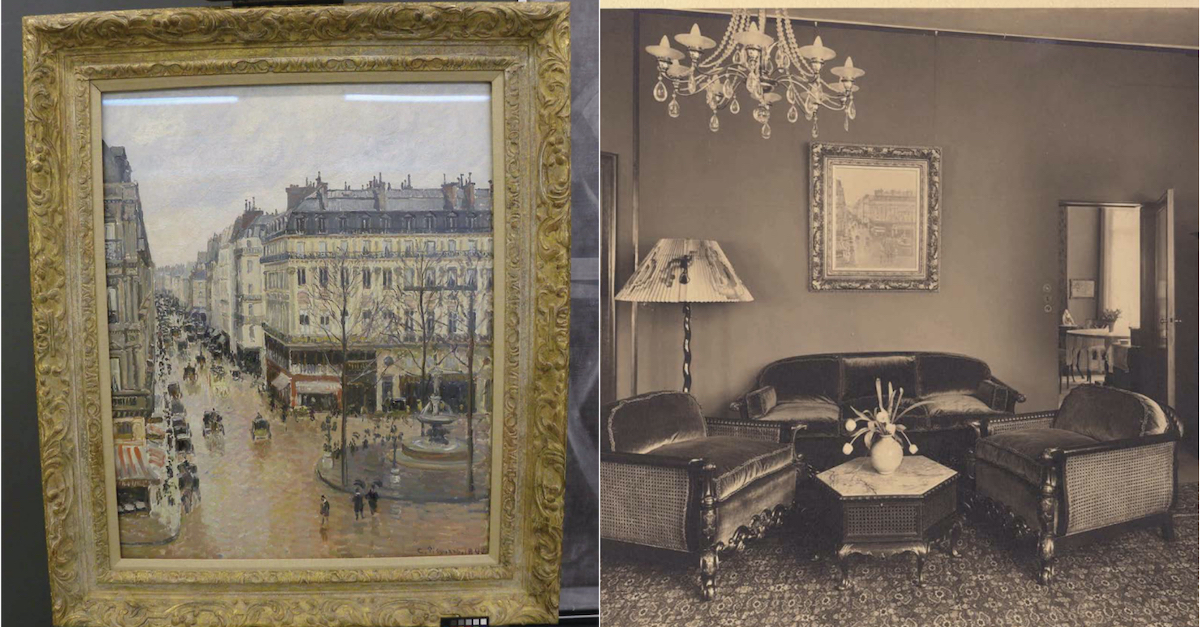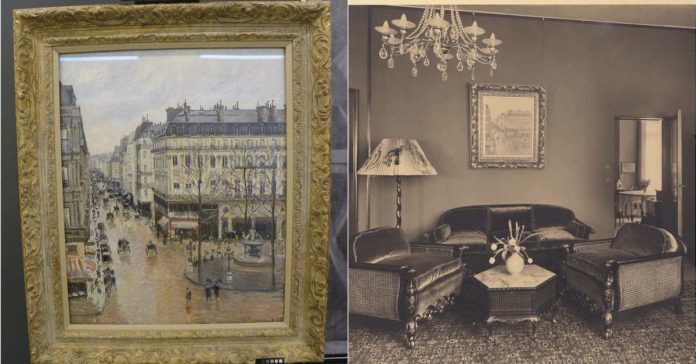
On the right, Camille Pissarro’s “Rue Saint-Honoré, Afternoon, Effect of Rain.” On the left, the painting is seen hanging in the parlor of the family from whom the Nazis looted the impressionist masterwork (images via court filing).
A family once forced to give up their impressionist masterpiece in order to escape Nazi Germany suffered a major legal loss Tuesday when a federal appeals court ruled in favor of the Madrid art museum seeking to keep the looted painting.
The painting
The work at issue is “Rue Saint-Honoré in the Afternoon, Effect of Rain,” a Paris streetscape by impressionist master Camille Pissarro. The painting is one in a series of fifteen works that Pissarro painted from the window of his hotel in the Place du Théâtre Français during the winter of 1897 and 1898. It is now valued at approximately $40 million.
Pissarro was an early Danish-French Impressionist painter who has been credited by some as beginning the art movement that would come to include Claude Monet, Pierre-Auguste Renoir, Paul Cézanne, and many others. In 1900, visionary art agent Paul Durand-Ruel sold Pissarro’s “Rue Saint-Honoré, Afternoon, Rain Effect” to Paul Cassirer, a prominent German-Jewish art dealer who was a key promoter of the works of Vincent van Gogh.
In 1926, Cassirer shot himself during divorce proceedings with his wife, stage actor Tilla Durieux, then died a few hours later. Upon Cassirer’s death, his sole living relative, Lilly Cassirer, inherited the Pissaro and displayed it in her home. Lilly was forced by the Nazis to “sell” the painting for 900 reichsmarks — approximately $360 — in 1939 in exchange for an exit visa to England.
Lilly sought safety in the U.S. and the painting was believed lost. In 1954, the U.S. Court of Restitution recognized Lilly’s loss. She was thereafter awarded $13,000 in compensation from the German Federal Republic.
Unbeknownst to the the Cassirers, Pissarro’s masterpiece had traveled to the U.S. and was acquired by a California gallery owner in 1951. It changed hands within the U.S. for years, and in 1976, a German steel scion named Baron Hans Heinrich von Thyssen-Bornemisza bought the painting on consignment. Much later, in 1993, the baron created a foundation and began the Thyssen-Bornemisza Museum in Madrid, to which he sold the Pissarro.
A childhood memory becomes a lengthy lawsuit
Upon seeing the painting publicized as part of the museum’s collection, Claude Cassirer — Lilly’s grandson — recognized it as something that had hung on the parlor wall in his grandmother’s home as he played as a child. The family notified the Spanish government in 2001 and began legal action to recover the artwork in 2005.
Lilly died in 2010, and Claude’s grandson, David Cassirer, continued the legal battle against the museum.
Before any court can decide the identity of the rightful owner of the Pissarro, it must first ascertain which is the correct set of laws to apply to the dispute. The analysis required for that preliminary step is highly complex, as the locus of the dispute is unclear.
The United States Supreme Court ruled unanimously in April 2022 that California choice of law rules — not federal — apply to the Cassirers’ restitution claims. However, as Justice Elena Kagan wrote at the time, “The underlying question in this case — which this opinion will not resolve — is whether the Cassirer family can get the painting back.”
The Cassirers lose, for now
When the federal court applied California’s choice of law rules, the parties continued to disagree about which substantive property-ownership law should apply under those rules. The U.S. Court of Appeals for the 9th Circuit ruled Tuesday that California procedural law dictates the application of Spanish property law in the dispute.
The decision about which law to apply was an important one for the case’s ultimate outcome. California law does not allow a possessor of stolen property to ever acquire rights superior to those of the true owner until the statute of limitations expires. By contrast, Spanish law does permit a person who acquired stolen property to obtain some rights in that property in some circumstances. The Cassirers argued that Spain’s law should be ignored, because it is both archaic and out of step with international norms regarding Nazi looted art.
The Biden administration supported the Cassirers’ position.
The panel of the 9th Circuit, however, disagreed, reasoning that their task is not to simply choose the better law. Rather, it must assess the extent to which each sovereign is committed to seeing its own law applied, said the court. Given the case’s minimal connection with California, the judges concluded that Spain would be especially aggrieved by a decision applying California law to the case.
A three-judge panel of George W. Bush appointees sided unanimously against the Cassirers. Presiding over the case were U.S. Circuit Judges Carlos Bea, Sandra Segal Ikuta, and Consuelo Callahan.
Bea wrote for the panel and explained that Spain has a “strong interest” in ensuring that its laws “will predictably regulate conduct that occurs within its borders.”
Bea wrote:
Moreover, applying California law based only on the Cassirers’ choice of residence would mean that Spain could not provide any “reasonable assurance[s]” to persons who possess property within Spain’s borders that Article 1955 would ever protect them from replevin or damages actions by California claimants.
Callahan said in a separate concurrence that while she agrees with the result in the ruling, it was “at odds” with her “moral compass.”
In an email to Law&Crime Thursday, the Cassirer’s legal team slammed the Ninth Circuit’s ruling as “a green light to looters around the world,” and said Tuesday that their clients are especially motivated to continue challenging Nazi-looted art in light of the “explosion of antisemitism in this country and around the world today.”
The team took issue with the court’s finding that California lacks a significant nexus to the dispute, saying that the state’s laws “strongly support the rights of its residents to recover stolen works of art in the hands of museums.”
Further, they challenged the court’s decision to subordinate California’s interests to Spain:
Among the important issues, the Court’s decision fails to explain how Spain has any interest in applying its laws to launder ownership of the spoils of war, a practice outlawed in the Hague Convention of 1907, and a series of other international agreements joined by Spain for over a century. Nor does it explain how a national museum owned by the Spanish government justifies holding onto a painting that it knows was looted by the Nazis from a Jewish family in the Holocaust.
The team said that they plan to seek en banc review from the full 9th Circuit, and pledged to continue fighting “honestly and vigorously” to recover artwork looted by Nazis ad during the course of other atrocities.
Counsel for the Thyssen-Bornemisza Museum did not immediately respond to request for comment.
You can read the panel’s ruling here.
Have a tip we should know? [email protected]

